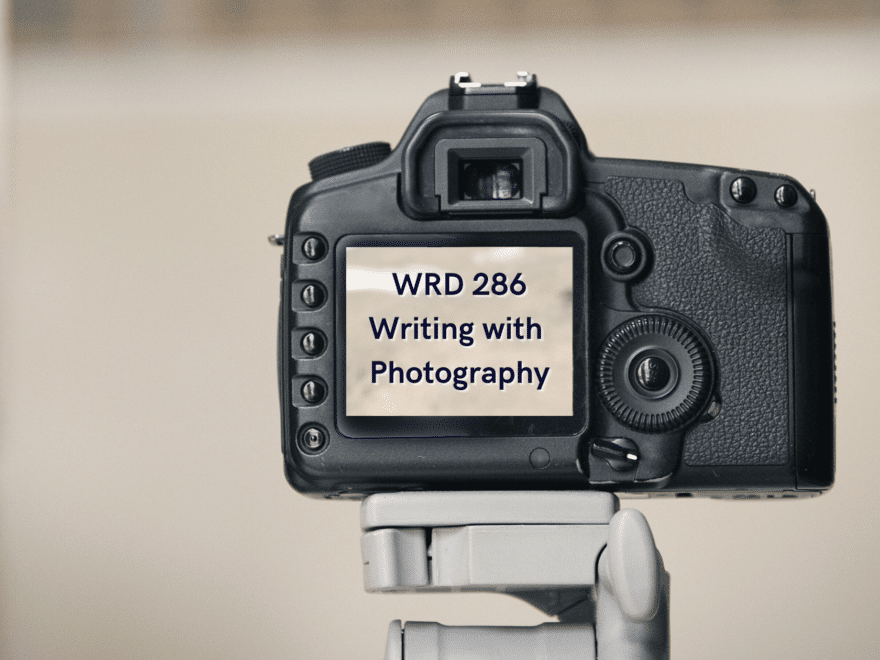This upcoming Autumn Quarter, the WRD Department will be offering another iteration of WRD 286: Writing with Photographs. While the WRD Blog published a post outlining the course when it was taught by Professor Lisa Dush, this additional spotlight looks through the lens of Professor Justin Staley, who will now be teaching the course for the third time.
Read on for Professor Staley’s perspective on this exciting class, including how it engages students in essential skills and practices “to understand that world more deeply.”
What interests you about teaching Writing with Photographs?
JS: Everything. WRD 286 was designed by Professor Dush and we used to talk about the course and our love for writing and photographs. I’ve been fascinated with the relationship between language and photographs since I took a graduate school class called Writing and Photography with Sasha Hemon, who was about to publish The Lazarus Project, a novel that utilized language and photographs in its storytelling.
When Professor Dush was unable to teach the class, I was thrilled that she asked me to teach it. I’ve taught the course twice and absolutely love it. There’s a visual and aesthetic appeal that a photograph makes or has, and I think the proliferation of the image (including photographs) has altered the way we view the world, and ourselves. There can also be something very philosophical about it, for the sort of existential pause a photograph provides, and I’m fascinated by the relationship between photographs and memory. In a sense, writing with photographs can explore the gap between existence and memory, as well as how and where they overlap.
Do students need photography experience or equipment to take the course?
No experience needed whatsoever, though I suspect many students have experience with basic photography and editing on their phones. Students can use different cameras such as DSLR or point and shoot cameras (their own or borrowed from WRD or the library), but they’re also welcome to use their phones if that’s what they’re most comfortable with. In the class, we’ll learn about and discuss different techniques of photography like composition, light/dark, aperture, shutter speed, and more; and with our understanding of how these characteristics affect our images, we also practice editing photographs. I hope students leave the course with a better understanding of approaches to photography and what makes a good photograph.
Are there any major projects and/or readings students will complete?
Students will likely complete a Memory Photoessay, in which they explore a memory or event from their past using writing and both private and public photographs; and a Documentary Photoessay, in which students document an individual or cultural group, utilizing new and original photographs of both people and their environment(s). In between those major projects we’ll discuss various texts—essays, novels, book chapters—that both explore and demonstrate the principles behind the assignments.
What are some outcomes students should expect to take away from the course?
Students will learn some photography techniques, as well as come to understand what makes a good photograph, perhaps even come to understand more deeply photography as an art. But more importantly, students will come to understand the relationship between language and photographs in form, content, and rhetorical objective: how each mode can enhance the other, call attention to the other, perhaps even have an ironic relationship or disconnect between one other. Ideally students will learn how to use writing and photographs to analyze, reflect, express, inform, and persuade. Ultimately, we want students to write more deeply about events in their lives, as well as the world around them.
Finally, why does learning to write with photographs matter?
I think the proliferation of the image over the last century has proven the importance of photography as a mode of communication, as a form of expression and persuasion, as an art. The image has become a—if not the—universal language. More recently, the internet has underscored the importance of multimodal communication: we usually don’t just read texts, but we look at images, watch videos. You can look at the front page of a newspaper (or go to a newspaper website) to get a feel for the importance of both words and images (especially photographs). I don’t believe we’re headed for a post-text future exactly, but I do believe it’s important to utilize numerous modes of communication to compete with the noise of the rest of the world, and to be able to understand that world more deeply.
